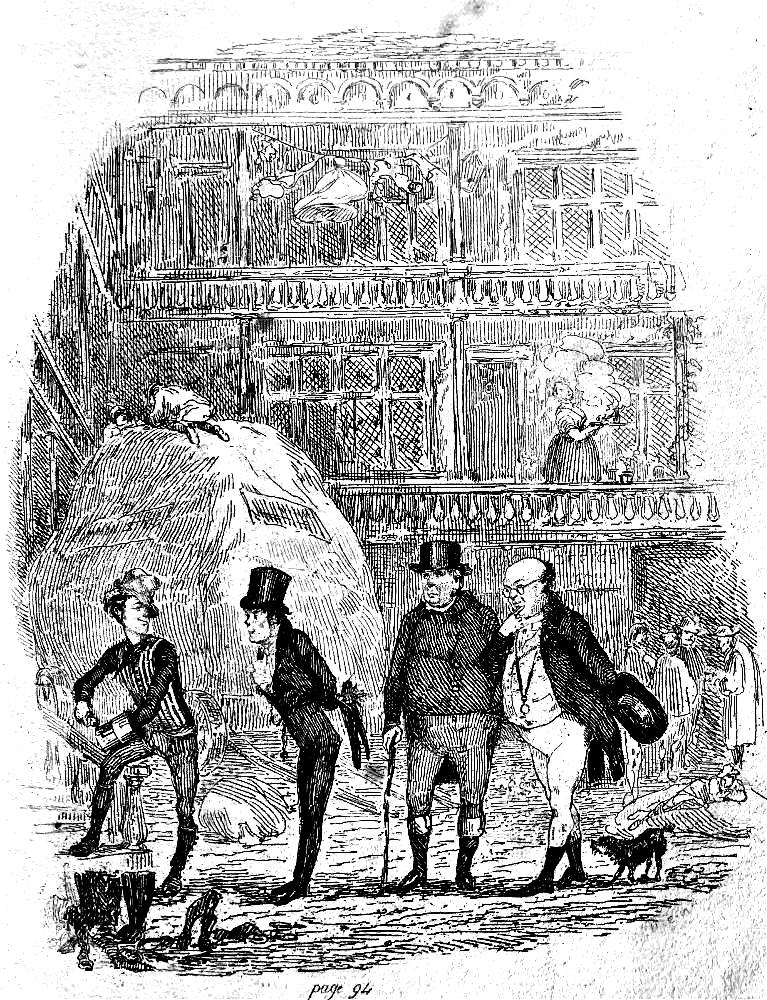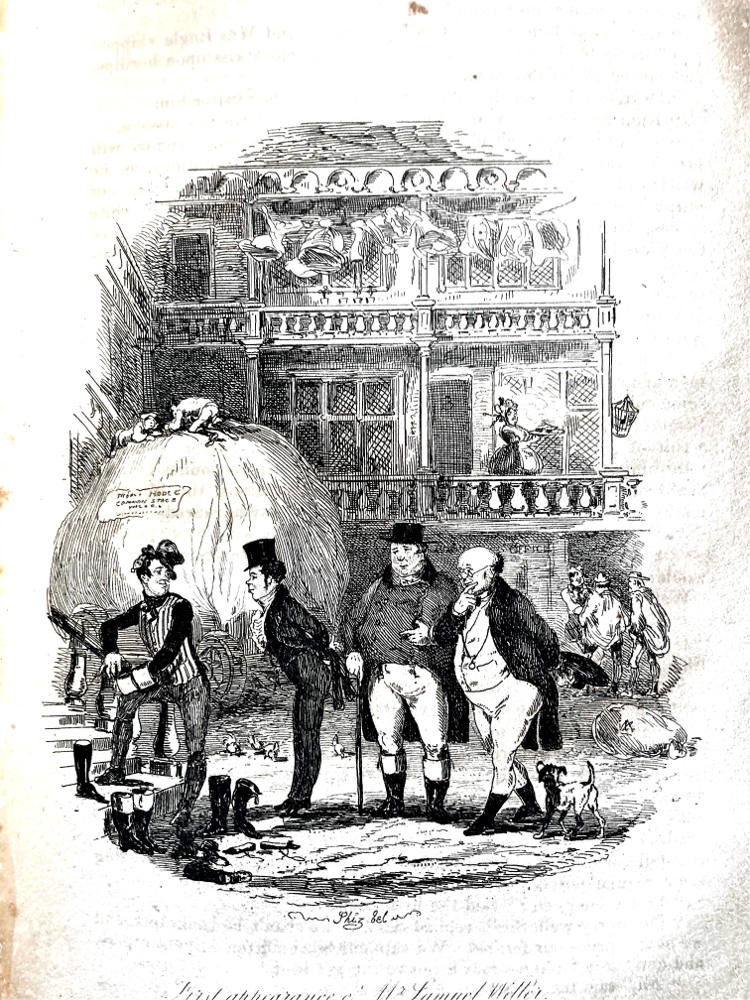The Evolution of Phiz's "Weller" Plate for Pickwick Papers



Versions of First Appearance of Mr. Samuel Weller. Left: Page 94 (the "broken walking-stick" plate from the fourth serial number, July 1836). Centre: Phiz's presentation draft for the Chapman and Hall re-engraving project: the pen-and-wash drawing (prior to November 1837). Right: Redrafted engraving First Appearance of Mr. Samuel Weller in the volume edition (published on 17 November 1837). [Click on these images for larger pictures.] All three courtesy of C. Ralph Hayes, Sidney, British Columbia.
Passage Illustrated in the July 1836 Number:
He [Jingle] was yet on his way [back] to the White Hart, when two plump gentleman and one thin one entered the yard, and looked round in search of some authorised person of whom they could make a few inquiries. Mr. Samuel Weller happened to be at that moment engaged in burnishing a pair of painted tops, the personal property of a farmer who was refreshing himself with a slight lunch of two or three pounds of cold beef and a pot or two of porter, after the fatigues of the Borough market; and to him the thin gentleman straightway advanced.
"My friend," said the thin gentleman.
"You're one o' the adwice gratis order," thought Sam, "or you wouldn't be so wery fond o' me all at once." But he only said — "Well, Sir."
"My friend," said the thin gentleman, with a conciliatory hem — "have you got many people stopping here now? Pretty busy. Eh?"
Sam stole a look at the inquirer. He was a little high-dried man, with a dark squeezed-up face, and small, restless, black eyes, that kept winking and twinkling on each side of his little inquisitive nose, as if they were playing a perpetual game of peep-bo with that feature. He was dressed all in black, with boots as shiny as his eyes, a low white neckcloth, and a clean shirt with a frill to it. A gold watch-chain, and seals, depended from his fob. He carried his black kid gloves in his hands, and not on them; and as he spoke, thrust his wrists beneath his coat tails, with the air of a man who was in the habit of propounding some regular posers. — Chapter 10, July 1836 [Part 4], p. 94
The Evolution of the Plate introducing Sam Weller (July 1836 through 17 November 1837)
The provenance of these three versions of the celebrated introduction of the inimitable Sam Weller is fascinating. When the serial run finished, Chapman and Hall decided to contract Hablot Knight Browne to revise the entire series of copper plates as steel engravings since this medium would yield more impressions. Accordingly, Phiz corrected the "broken cane" illustration, in which Wardle's cane through an engraving error appears to broken in the middle, and provided a wholly new, much more detailed version of the illustration for the first volume edition (17 November 1837). Accordingly, he drafted for the approval of the publisher and author a sample in pen-and-wash drawing which represents a considerable advance in both clarity and pleasing detail.
Although Mr. Pickwick looks much the same in all three iterations, Phiz seems to have re-thought the figure of Pickwick's companion, Mr. Wardle, the owner of Manor Farm at Dingley Dell, Kent. As the central figure in the composition, Wardle must complement Mr. Pickwick, so that Phiz transforms him from a fat man with spindly legs in the "broken cane" illustration to an even stouter man with much more substantial legs, and Wellington topboots. The transformation occurs between the original serial illustration, which bears the caption Page 94 (to indicate where in the volume the book-binder should insert the copper-plate engraving in the bound volume of the collected serial numbers), and the finished version for the 17 November 1837 volume publication, First appearance of Samuel Weller, a superior steel engraving which incorporates the detailing, shading, and sharper background of the White Hart seen in the sample pen-and-wash drawing which Phiz submitted for Dickens's consideration in the autumn of 1837.
Several other features of the original demonstrate the artist's and perhaps even the author's re-thinking of the scene in the inn yard: the group of four carters in the original (right) has become three slightly larger and better defined figures; in the revision, Wardle's Regency pantaloons have become white, and he now wears a tailcoat and a hat with a smaller crown; and the dog immediately beside Pickwick is rather more animated, sporting an erect tail. Perhaps the most satisfying improvements are Phiz's defining and elaborating upon the boots which are awaiting Sam Weller's buffing and polishing (lower left), and the notice on the haystack, immediately above Sam's head. But equally noteworthy are the more sharply defined architectural detailing in the gallery, and the illustrator's including a birdcage (centre right). The pen-and-wash study and its derivative, the 17 November 1837 engraving, are thus far more visually pleasing than the original copper engraving.
It is quite possible that by the time he was drafting the presentation illustrations for the 1837 volume edition Phiz had abandoned the time-honoured quill-pen for a recent innovation, the "Japanese" steel-tipped pen. In fact, the originator of this drawing device was an Englishman, John Mitchell of Birmingham, who introduced the machine-made steel pen point in 1828. Two years later, another English inventor, James Perry, produced more-flexible steel points by cutting a centre hole at the top of a central slit, with additional slits on either side. A follower of the Victorian Web has commented upon this Phiz drawing that
it seems clear he was using the fairly new-fangled steel pens for making the sketch. They were a real boom for artists doing pen and ink drawings, and so much more consistent in line quality than quills, which became softer with use and would need to be switched out regularly. Steel pens are still used by many artists and cartoonists, especially for manga from Japan. [Personal communication via Twitter @planecrazy, 25 April 2022].
A Note on the Provenance of the Pen-and-Wash Drawing
The Phiz pen and ink wash was purchased by me through a broker in the United Kingdom. The elderly lady who sold it to me had had it in her family since her grandfather purchased it at an auction in 1924. — C. Ralph Hayes, Sidney, British Columbia.
Bibliography
Bolton, H. Philip. Dickens Dramatized. London and Boston: Garland and G. K. Hall, 1987.
Cohen, Jane Rabb. Charles Dickens and His Original Illustrators. Columbus: Ohio State U. P., 1980.
Dickens, Charles. The Posthumous Papers of the Pickwick Club. Illustrated by Robert Seymour, Robert Buss, and Phiz. London: Chapman and Hall, November 1837. With 32 additional illustrations by Thomas Onwhyn (London: E. Grattan, April-November 1837).
Dickens, Charles. Pickwick Papers (1836-37). Illustrated by Hablot Knight Browne. The Household Edition. Vol. VI. London: Chapman and Hall, 1873.
Dickens, Charles. Pickwick Papers (1836-37). Illustrated by Thomas Nast. The Household Edition. New York: Harper & Bros., 1873.
Dickens, Charles. Pickwick Papers (1836-37). Illustrated by Sol Eytinge, Jr. The Diamond Edition. Boston: Ticknor & Fields, 1867..
Dickens, Charles. Pickwick Papers (1836-37). Illustrated by Hablot Knight Browne. The Charles Dickens Edition. Boston: Ticknor & Fields, 1867. Facing p. 78.
Hammerton, J. A. The Dickens Picture-Book. The Charles Dickens Library Edition, Vol. 18. London: Educational Book Co.,1910.
Johnannsen, Albert. "Part IV, Plate 11, Page 945: First Appearance of Mr. Samuel Weller." The Posthumous Papers of The Pickwick Club. Chicago: University of Chicago Press, 1956. Pp. 22-24.
Steig, Michael. Dickens and Phiz. Bloomington & London: Indiana U.P., 1978. Pp. 51-85.
Created 15 April 2022 Last modified 23 February 2024